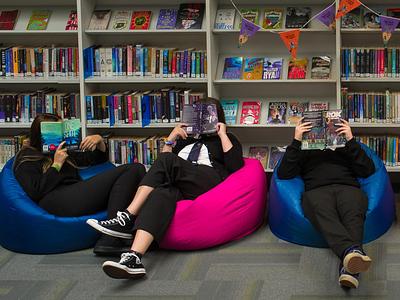Looking for all Articles by Hannah Sycamore?
Using books to support children transitioning from primary to secondary school
Ideas and tips for teachers using books to support children starting secondary school

Using books to support transition is a great way to encourage reading for pleasure across your school and shows pupils that you are a school that values and prioritises reading from the outset. Sharing the same book across a year group creates a shared experience for all entrant pupils and generates common ground for conversation. Reading the same book can also offer excellent opportunities to support Health and Wellbeing, as pupils adjust to unusual school patterns and new styles of learning.
Choosing the right book
We know schools across Scotland often use reading for pleasure to support the primary to secondary transition, but if you are investing in a large number of copies, it can be tricky to know which book to select. At Scottish Book Trust, teachers often ask us to recommend books for transition projects. Of course, it depends on the group you are working with, but we have a few general points to consider before selecting a book:
- Choose a book that is accessible to all pupils, including less confident readers.
- Choose a book with an interesting theme to generate discussion and debate.
- Choose a book that holds suspense and keep pupils guessing, generating conversations.
- Choose a book that creates a buzz of excitement in the classroom.
- Perhaps consider a lesser-known book which is new to most pupils.
One book will not cover all these areas, so focus on which areas might suit your setting, your new pupils, and the project best. Titles such as Welcome to Nowhere or A House Without Walls by Elizabeth Laird will create lots of discussion and debate on contemporary themes. A thrilling read like Evernight by Ross Mackenize will generate excitement around reading. Something like The Wild Book by Juan Villoro (translated by Lawrence Schimel) will be unfamiliar to most pupils and a new reading experience for all. For books specifically on transition or starting at a new school, explore our list of great books for children starting secondary school.
Book formats and interactivity
You might also want to consider different formats and explore which books are available as audiobooks too. For example, Crossover by Kwame Alexander is available as a graphic novel and an audiobook, which might suit the needs of a varied cohort. You could choose a book that links to one of our Authors Live events, especially the On Demand library(this link will open in a new window) so that pupils can all enjoy an author event together. Crossover is discussed in Kwame Alexander's virtual Authors Live event(this link will open in a new window). Alternatively, you might opt for a Scottish author such as Ross Mackenzie to make the most of Scottish Book Trust's Live Literature funding(this link will open in a new window). We fund author events in schools, so you could apply to have the book author you choose to visit your school to work with your new S1 pupils.
Financing your book transition project
Financing or supplying books to pupils can be challenging, and we know this can often be a barrier to sharing books across a year group. Some schools use their PEF (Pupil Equity Funding) to purchase books, and you could explore other funds available to schools that might support a book project.
However, it's important to remember that you don't always need to get physical copies of books into students' hands to run a transition project that creates a shared reading experience. Feeder primaries could read the book aloud to pupils at the end of the summer term, and this can be continued in the first few weeks of secondary school by the English and other departments. Reading aloud means fewer copies of a title need to be purchased (if financing a project is tricky) but still allows for a shared experience. A book with lots of suspense and possibly a plot twist or cliff-hanger would be a good choice in this instance to keep pupils guessing what happens next over the summer break!
Another option is sharing online or digital books that are free to access. Pupils still enjoy a shared reading experience, but the project costs are lower. For example, Scottish Book Trust has the Graphic Novel Earth Planet Universe(this link will open in a new window), which is available to download for free. The book explores the life of John Muir and is excellent for inspiring discussion of nature and climate change. The Book of Hopes(this link will open in a new window) is also still available to access free from the National Literacy Trust. Written during lockdown, it has stories, extracts, poems and illustrations all on the theme of hope and would make a great starting point for a transition project on the future, as well as encouraging pupils to try new formats or genres. It is also available as a hard copy, so could be shared with pupils who don't have digital access.
Whatever book you choose, using books and reading for pleasure to support transition is a great way to settle pupils into their new school. Reading a book together gives young people a shared topic of discussion when starting conversations can seem challenging with so many unfamiliar faces. Reading has also been shown to improve health and wellbeing and is ideal for helping pupils to deal with change.
Further resources
Feeling inspired to start your own project? Take a look at our other resources for supporting the primary to secondary transition.
- Browse books on our list of great books for children starting secondary school.
- Download our transition journal resource to print and give to pupils.
- Take a look at our learning resource for 10 things do do with any book: transition(this link will open in a new window).